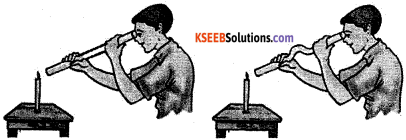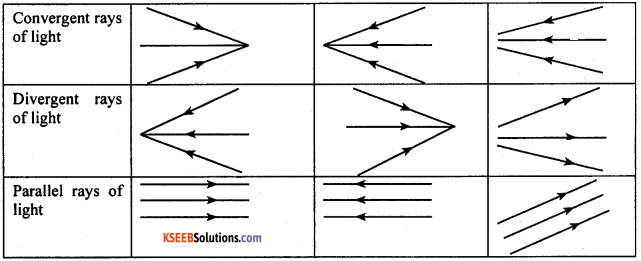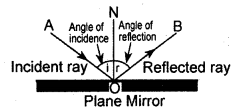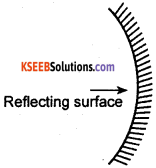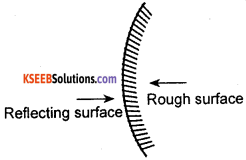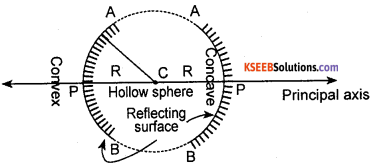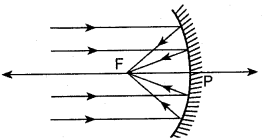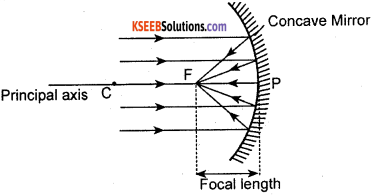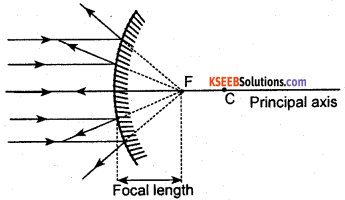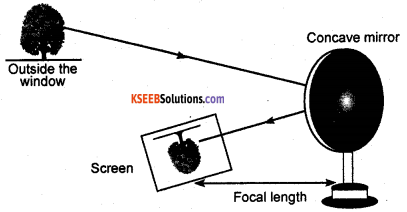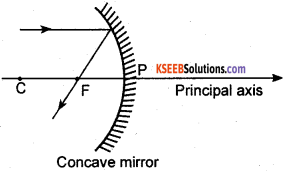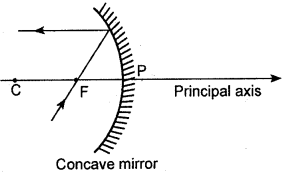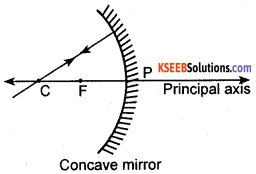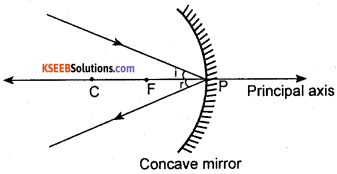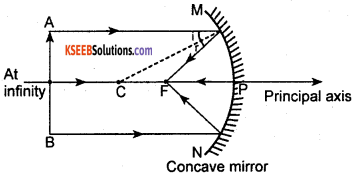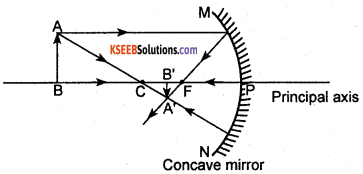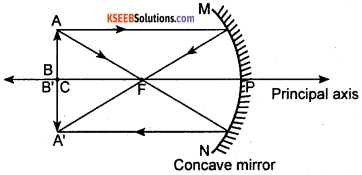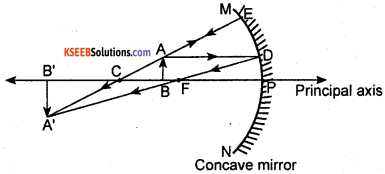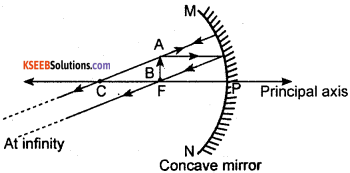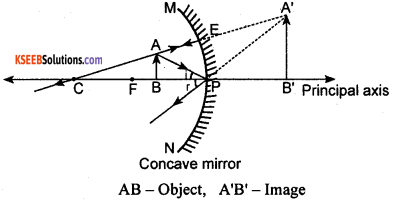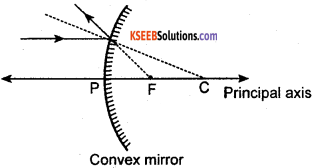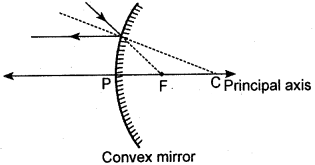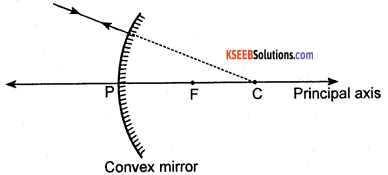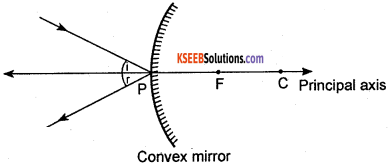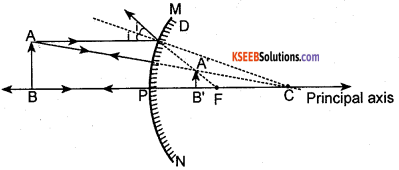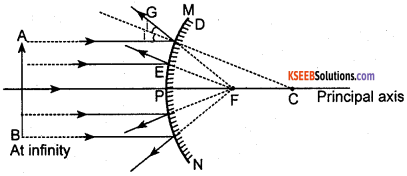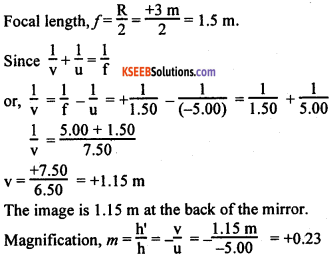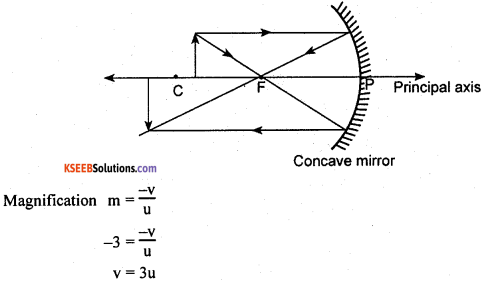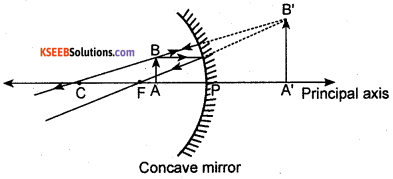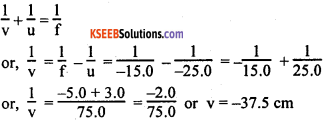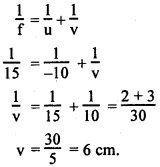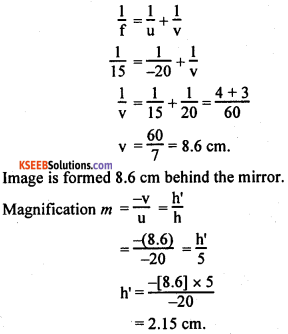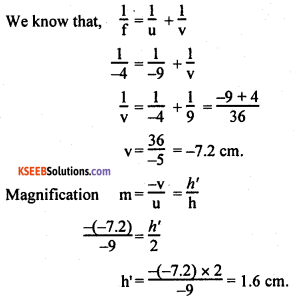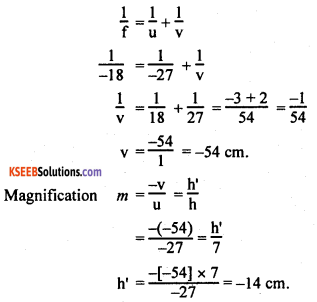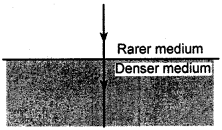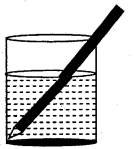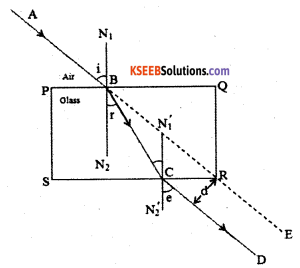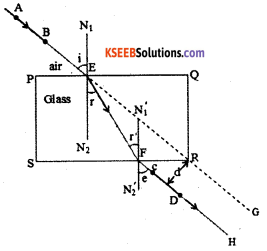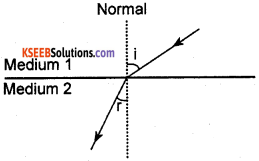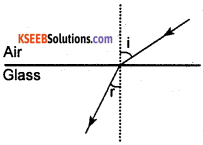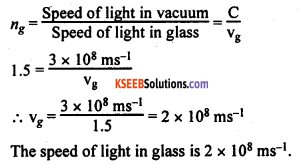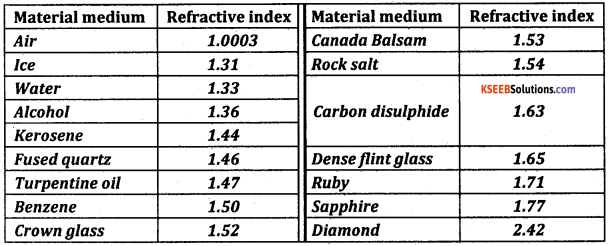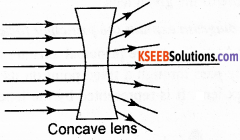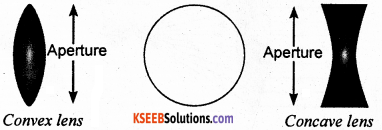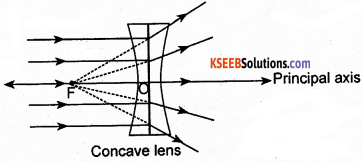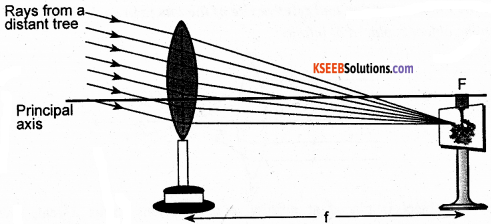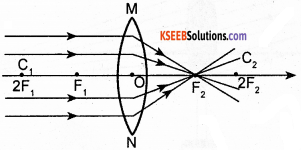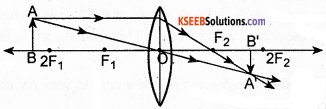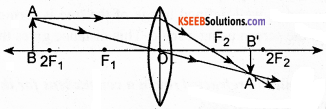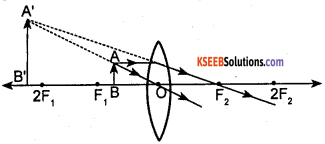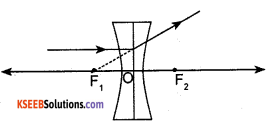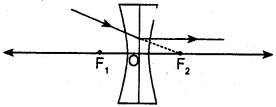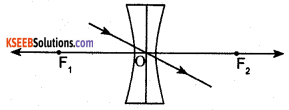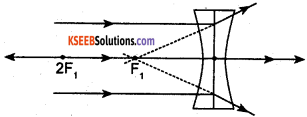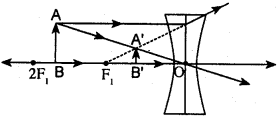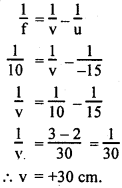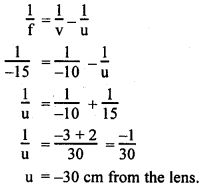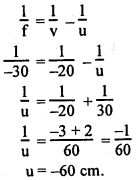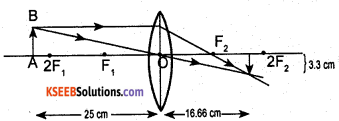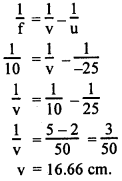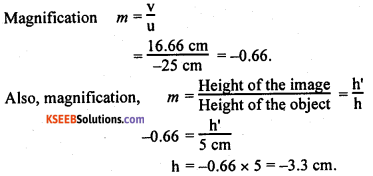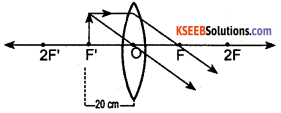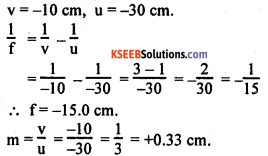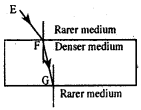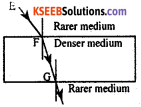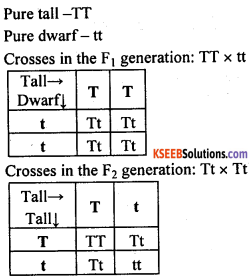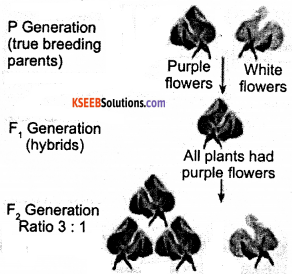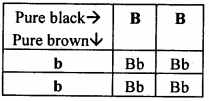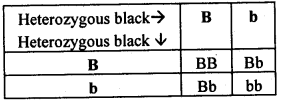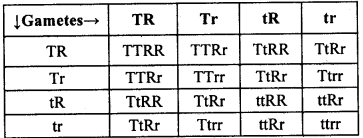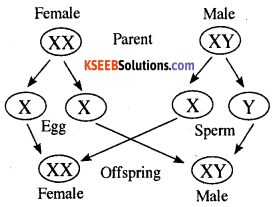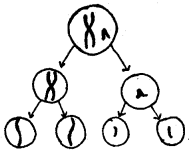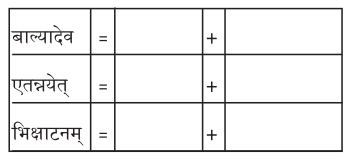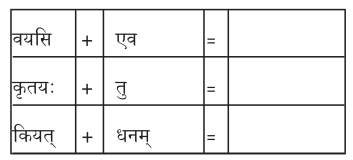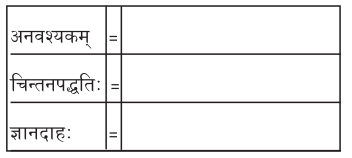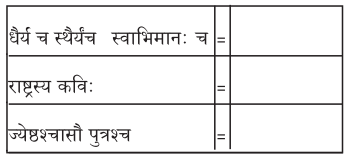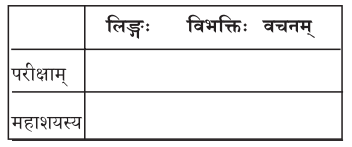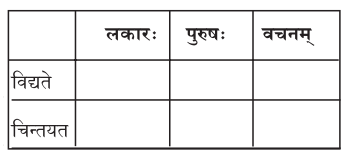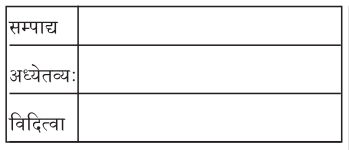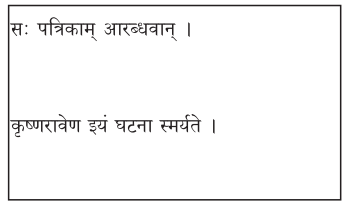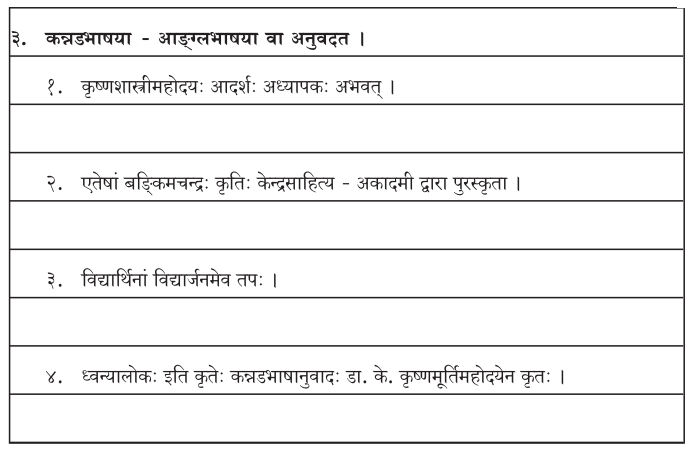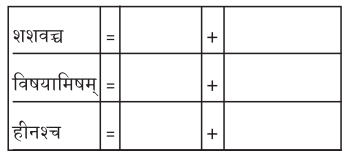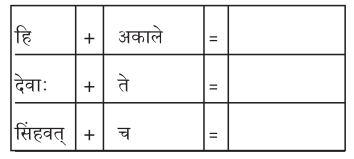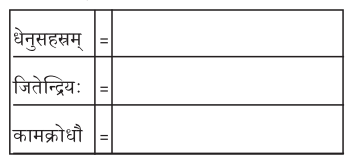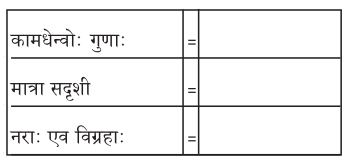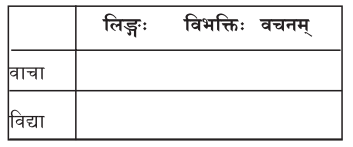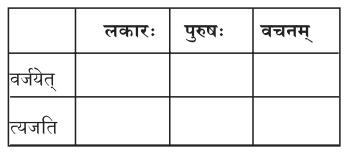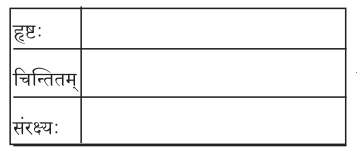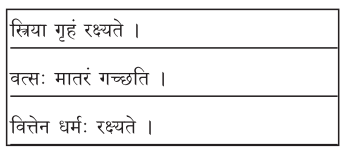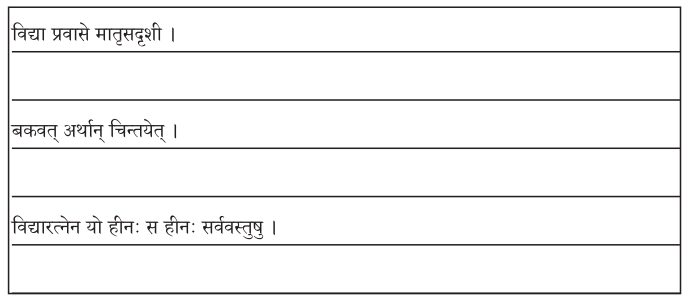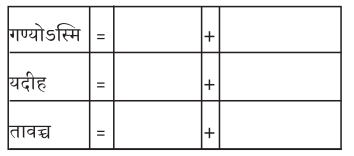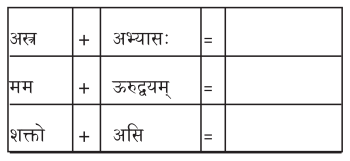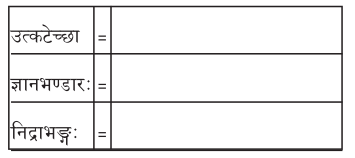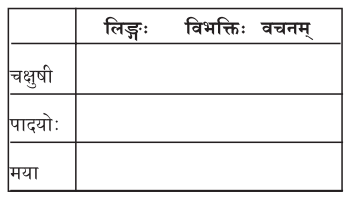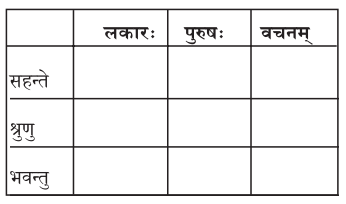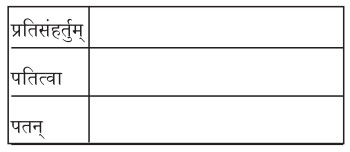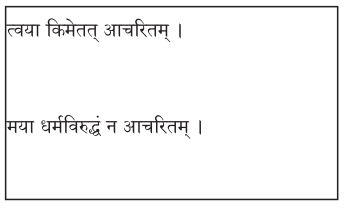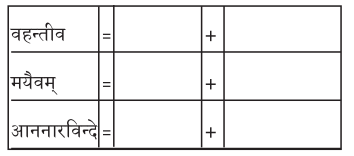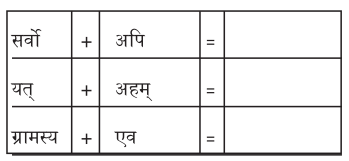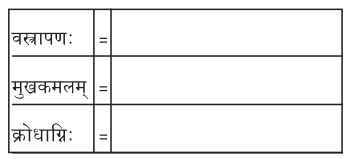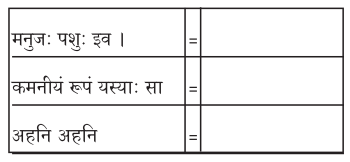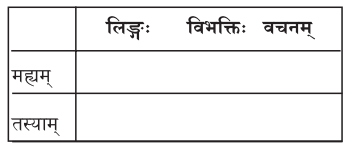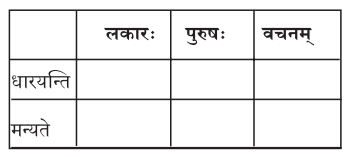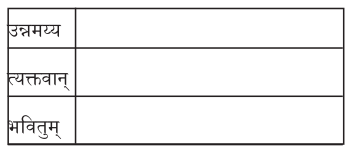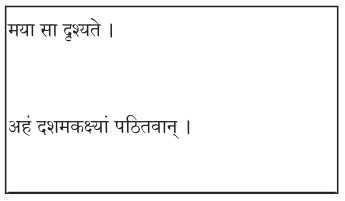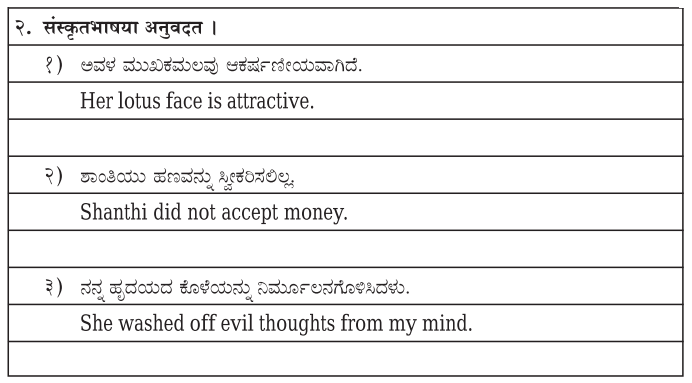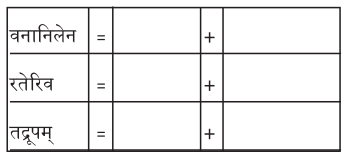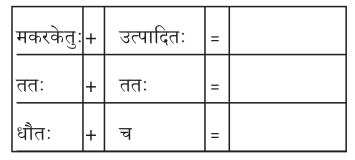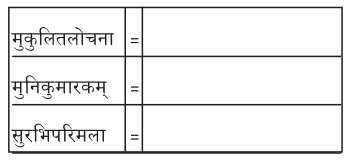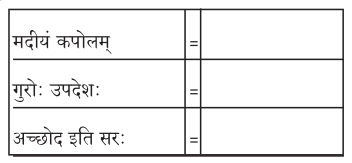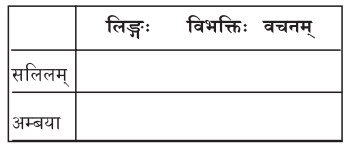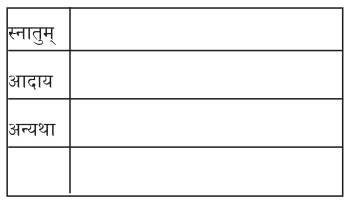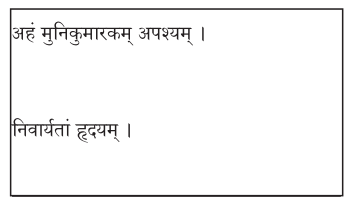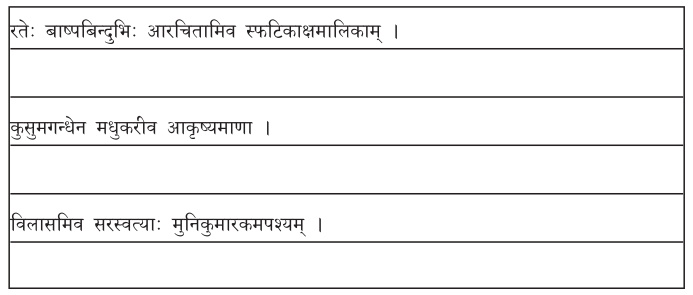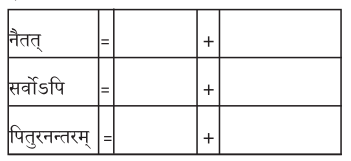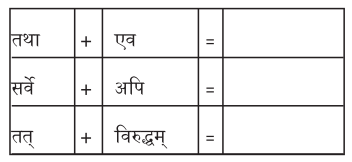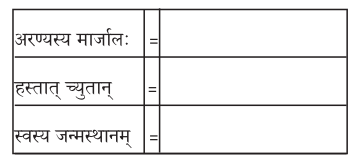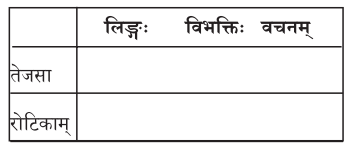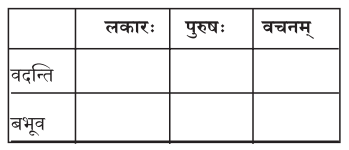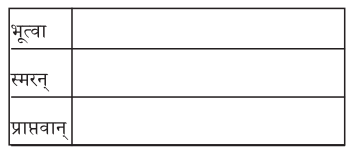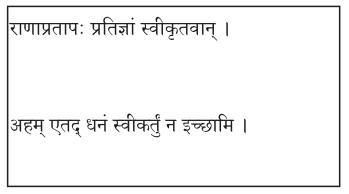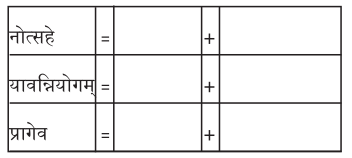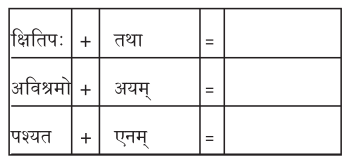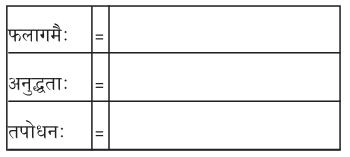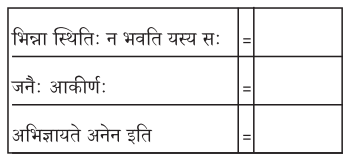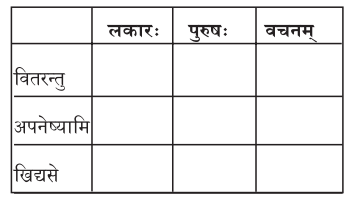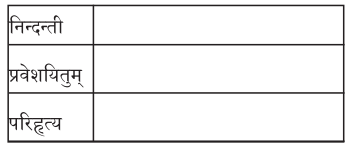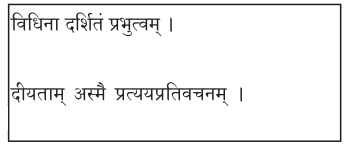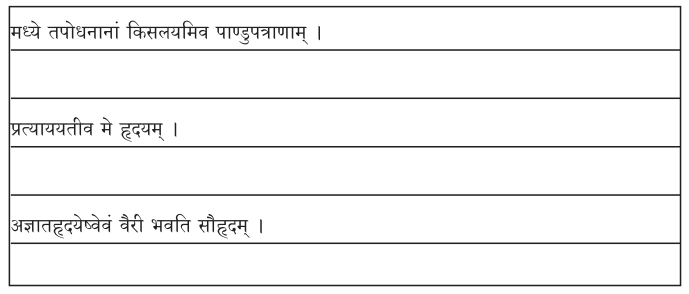Students can download Class 10 Science Chapter 11 Human Eye and Colourful World Important Questions, KSEEB SSLC Class 10 Science Important Questions and Answers helps you to revise the complete Karnataka State Board Syllabus and score more marks in your examinations.
Karnataka SSLC Class 10 Science Important Chapter 11 Human Eye and Colourful World
Question 1.
Draw a neat diagram of the human eye and label the parts.
Answer:
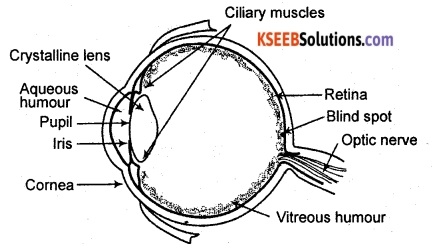
Question 2.
What is the screen of the human eye called?
Answer:
The screen of the human eye is called retina.
Question 3.
What type of lens is present in the human eye? What is its function?
Answer:
In the human eye, there is a convex lens. The eye-lens provides the finer adjustment of focal length so that the light rays from objects get focussed on the retina of the eye.
![]()
Question 4.
What is cornea? What is its Junction?
Answer:
The transparent portion of the outermost coat of the human eye is called cornea. Cornea refracts most of the light rays that enter the eye and direct them to the retina.
Question 5.
What is pupil of the eye? Write its function.
Answer:
The opening of the iris through which light enters the eye is called pupil. The pupil regulates and controls the amount of light that enters the eye by adjusting its diameter. This is achieved by contraction and dilation of the iris.
Question 6.
What is the function of ciliary muscles of our eye?
Answer:
Ciliary muscles of our eye hold the eye lens in position. These muscles help to adjust the focal length of the eye lens for seeing both nearby and distant objects.
Question 7.
Name the diaphragm that controls the size of thepupiL
Answer:
The muscular diaphragm that controls the size of the pupil is called iris.
Question 8.
What is the nature of the image formed on the retina of the eye?
Answer:
The image formed on the retina is real, inverted and smaller than the object.
![]()
Question 9.
What is the function of the optic nerves?
Answer:
The optic nerves in our eyes transmit the image formed on the retina to the brain in the form of electrical signals.
Question 10.
What is meant by power of accommodation of the eve?
Answer:
Our eye can focus clearly all objects that are beyond 25 cm by adjusting the focal length of its lens. The ability of the eye lens to adjust its focal length is called power of accommodation.
Question 11.
What happens to the image distance in the eve when we increase the distance of an object from the eve?
Answer:
When the distance of an object from the eye is increased, the image distance remains same. The eye forms the image on the retina by adjusting the focal length of its lens.
Question 12.
How does the curvature of the eye lens change when eye is viewing
- Nearby objects
- Distant objects?
Answer:
The curvature of the eye lens will increase while viewing distant objects and the curvature of the eye lens will decrease while viewing nearby objects.
Question 13.
What is the near point of the human eve with normal vision?
OR
What is meant by least distance of distinct vision? What is its value?
Answer:
The minimum distance, at which objects can be seen most distinctly without strain is called the least distance of distinct vision. It is also called the near point of the eye. The value of least distance of distinct vision of the human eye is 25 cm.
Question 14.
Why is a normal eve not able to see objects placed closer than 25 cm clearly?
Answer:
Our eye can adjust the focal length of its eye lens to enable us to see both nearby and distant objects clearly. However, the focal length of the eye lens cannot be decreased below a certain minimum limit. Therefore, the object must be held at certain minimum distance to be seen clearly. This minimum distance is about 25 cm for a normal eye. Objects closer than this minimum distance cannot be seen without discomfort and strain to the eye.
![]()
Question 15.
What is far point of the human eve with normal vision?
Answer:
The farthest point up to which the eye can see objects clearly is called the far point of the eye. The far point of a normal human eye is infinity.
Question 16.
What is the range within which a normal human eye can see objects clearly?
Answer:
A. normal human eye can see all objects clearly which are between 25 cm and infinity.
Question 17.
What is cataract? How does it affect vision? How can it be corrected?
Answer:
Sometimes, the crystalline lens of our eye may lose its transparency and become milky and cloudy. This condition is called cataract. Cataract causes partial or complete loss of vision. Cataract is corrected and vision can be restored through a cataract surgery. In this surgery, the lens is removed and replaced by a synthetic lens.
Question 18.
Which are the common defects of vision that can be corrected by using spherical lenses?
Answer:
There are mainly three common defects of vision, which can be easily corrected with spherical lenses. They are:
- Myopia or near-sightedness,
- Hypermetropia or far-sightedness, and
- Presbyopia.
Question 19.
What is myopia? How is it caused?
Answer:
A defect of the eye that causes light to focus in front of the retina instead of directly on it, resulting in an inability to see distant objects clearly is called myopia. It is also called shortsightedness. A person with this defect has the far point nearer than infinity.
Myopia may arise due to any or both of the following reasons:
- Excessive curvature of the eye lens, and
- Elongation of the eyeball.
![]()
Question 20.
Draw a diagram showing the image formation in a normal eye and myopic eye while viewing distant objects.
Answer:
1. Normal eye:

2. Myopia (short sighted):
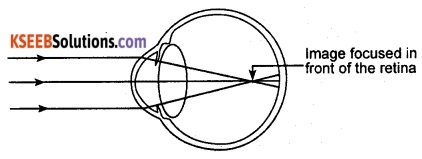
Question 21.
How is myopia corrected? Show this by a suitable diagram.
OR
Name the lens used to correct myopia.
OR
Draw diagrams to show
- Far point of a myopic eye,
- Myopic eye and
- Correction for myopia.
Answer:
Myopia can be corrected by using spectacles fitted with concave lenses of suitable power.
1. Far point of a myopic eye:
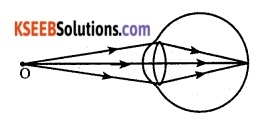
2. Myopic Eye:
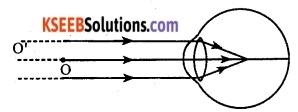
3. correction for myopia:
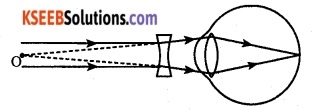
Question 22.
A person is wearing spectacles with concave lenses. What is the defect of vision he is suffering from?
Answer:
The person who is wearing spectacles with concave lenses is suffering from a defect called myopia or short-sightedness. This person has difficulty in seeing distant objects clearly.
![]()
Question 23.
A person with a myopic eve cannot see objects beyond 1.2 m distinctly. What type of corrective lens should be used to restore proper vision?
Answer:
The person with myopic eye has inability to see distant objects clearly. This person has far point nearer than infinity. This defect can be corrected and vision can be restored by using spectacles fitted with concave lens of suitable power.
Question 24.
A student has difficulty readme the blackboard while sitting in the last row. What could be the defect the child is suffering from? How can it be corrected?
Answer:
The student who has difficulty in reading the blackboard while sitting in the last row is having myopia or shortsightedness. This defect can be corrected by using spectacles fitted with concave lenses of suitable power.
Question 25.
The far point of a myopic person is 80 cm in front of the eve. What is the nature and power of the lens required to correct the problem?
Answer:
The person whose far point is 80 cm is having myopia as the far point of the eye is nearer than infinity. The person cannot see distant objects clearly. This problem can be corrected by using spectacles fitted with concave lenses (diverging lenses) of suitable power. Let us now calculate the power of the lens required to correct the problem.
Data: Object distance, u = -80 cm, image distance v = infinity (∞), focal length f = ?, power P = ?
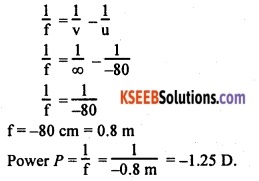
Concave lens of power -1.25 D must be used to correct the defect.
![]()
Question 26.
How does the use of concave lenses in spectacles restore the vision of distant objects in a myopic person?
Answer:
A person having myopia has difficulty in seeing distant objects clearly as the light from distant objects is brought to focus not on the retina but in front of it. Using spectacles with concave lenses will correct this condition. A concave lens of suitable power will bring the image back on to the retina and thus the defect is corrected.
Question 27.
What is hypermetropia? How is it caused?
Answer:
A defect of the eye that causes light to focus behind the retina instead of directly on it, resulting in an inability to see nearby objects clearly is called hypermetropia. It is also called long-sightedness. A person with this defect has the near point farther than 25 cm.
Hypermetropia may arise due to any or both of the following reasons:
- The focal length of the eye lens is too long.
- Contraction of the eyeball.
Question 28.
Draw neat diagrams to show
- Near point of a hypermetropic eye, and
- Hypermetropic eye.
Answer:
1. Near point of a hypermetropic eye:

2. Hypermetropic eye:

![]()
Question 29.
How is hypermetropia corrected? Show this by a suitable diagram.
OR
Make a diagram to show how hypermetropia is corrected.
Answer:
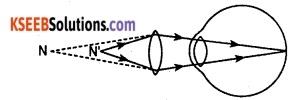
Hypermetropia can be corrected by using spectacles fitted with convex lenses of suitable power.
Question 30.
Observe the diagram given below and answer the questions that follow:
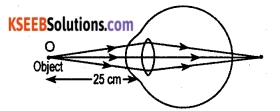
- Name the defect of vision represented in the diagram above. Justify your answer.
- Show by a diagram the correction of this defect.
Answer:
1. The defect of vision represented in the diagram is hypermetropia. This means the person has difficulty in seeing nearby objects clearly. The person is not able to see clearly an object kept at the normal near point of the eye.
2. Hypermetropia corrected:
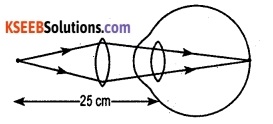
Question 31.
Observe the figure given. Name the eye defect indicated in the figure and also mention the lens
Answer:
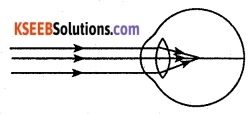
The defect of the eye shown in the figure given is called myopia or short-sightedness. It can be corrected by using spectacles with concave lenses of suitable power.
![]()
Question 32.
A man can read the route number of a distant bus clearly but he finds difficulty in reading a book. From which defect of the eye is he suffering from? What type of spectacles lens should be used to correct the defect?
Answer:
Since the man cannot see nearby objects (letters in the book) clearly, he is suffering from the defect of vision called hypermetropia. Hypermetropia is corrected by using spectacles containing convex lenses of suitable power.
Question 33.
The near point of a hypermetropic eve is 1 m. What is the power of the lens required to correct this defect? Assume that the near point of the normal eve is 25 cm.
Answer:
The image of the object at 25 cm must be shifted to a distance of lm for the object to be seen clearly. Given: Object distance, u = -25 cm; image distance, v = -1 m = -100 cm; focal length, f = ?; power, P = ?
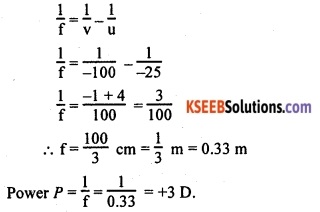
A convex lens of power +3 D must be used to correct the defect.
Question 14.
What is presbyopia? Explain. How can it be corrected?
Answer:
Long-sightedness caused by loss of elasticity of the lens of the eye, occurring typically in middle and old age is called presbyopia.
The power of accommodation of the eye usually decreases with ageing. For most people, the near point gradually recedes away. They find it difficult to see nearby objects comfortably and distinctly without corrective eyeglasses.
Thus, presbyopia arises due to the gradual weakening of the ciliary muscles and diminishing flexibility of the eye lens. Presbyopia can be corrected by using spectacles fitted with convex lenses of suitable power.
![]()
Question 35.
Some people in old age develop both myopia and hypermetropia. How can this problem be corrected?
Answer:
Sometimes, a person in old age may suffer from both myopia and hypermetropia. Such people require bifocal lenses for correcting their eye defect. A common type of bifocal lens consists of both concave and convex lenses. The upper portion consists of a concave lens. It facilitates distant vision. The lower part is a convex lens. It facilitates near vision.
Question 36.
A person needs a lens of power -5.5 dioptres for correcting his distant vision. For correcting his near vision he needs a lens of power +1.5 dioptre. What is the focal length of the lens required for correcting
- Distant vision
- Near vision?
Answer:
The power P of a lens of focal length/is given by the relation P = \(\frac{1}{f}\).
1. Correction for distant vision:
The person needs a lens of power -5.5 dioptre to correct myopia.
Power of the lens P = \(\frac{1}{f}\)
f = \(\frac{1}{p}\)
f = \(\frac{1}{-5.5}\) = – 0.812 m = – 18.2 m.
The person needs a convex lens of focal length 18.2 cm for correcting distant vision.
2. Correction for near vision:
The person is using a lens of power +1.5 dioptre to correct hypermetropia.
Power of the lens P = \(\frac{1}{f}\)
f = \(\frac{1}{p}\)
f = \(\frac{1}{1.5}\) = 0.66 m = 66.66 cm.
The person needs a convex lens of focal length 66.66 cm for correcting near vision.
Question 37.
What is a prism?
Answer:
Prism:

A transparent solid object, made of glass or any other transparent material having two identical triangular bases and bound by lateral surfaces in the form of parallelograms and usqd for separating white light passed through it into a spectrum is called a prism.
![]()
Question 38.
Show by a suitable diagram the path of a light ray through a triangular glass prism. Also show the angle of deviation in the prism.
Answer:
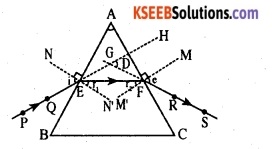
∠i – Angie of incidence, ∠D = Angle of deviation
Question 39.
What is meant by angle of deviation?
Answer:
When a ray of light passes through a prism, the angle formed between the direction of the incident ray and the emergent ray is called the angle of deviation.
Question 40.
What is meant by dispersion of light?
Answer:
The phenomenon of breaking up of composite light into its constituent colours is called dispersion of light.
Question 41.
How do you demonstrate the dispersion of light through a triangular glass prism?
Answer:
Take a thick sheet of cardboard and make a small hole or a narrow slit in the centre. Allow sunlight to fall on the narrow slit. Now, we get a narrow beam of white light through the hole. Pass the beam of white light through a glass prism.
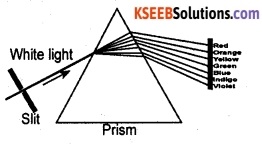
Turn the prism slowly until the light that comes out of it appears on a nearby screen. A beautiful band of seven colours appears on the screen. This is called visible spectrum. The sequence of colours from the bottom end of the spectrum is violet, indigo, blue, green, yellow, orange and red.
Question 42.
What causes dispersion of white light in a glass prism?
Answer:
Different colours present in composite light have different wavelengths. These colours travel at the same speed through air but travel at different speeds in a given refracting medium (glass). As a result, the refractive index of glass depends on the colour of light.
The various colours of white light undergo different angles of deviation as they pass through a glass prism. Lights of shorter wavelength deviate most while those of longer wavelengths deviate least. Therefore, the various components of white light separate as they pass through a glass prism.
![]()
Question 43.
Which colour of white light has the longest wavelength and which one has the shortest wavelength? Which colour deviates most and which colour deviates least on passing through a triangular glass prism?
OR
Mention the colour that bends the least and the colour that bends the most when light undergoes dispersion through a prism.
Answer:
Of the colours of white light, red has the longest wavelength and violet has the shortest wavelength. On passing through a prism, the red coloured light deviates least and violet coloured light deviates the most.
Question 44.
How can you show that white light consists of seven colours?
OR
Draw a neat diagram to show the recombination of the spectrum of white light.
Answer:
White light is composite light. This means that white light consists of more than one colour. When a ray of white light is passed through a triangular glass prism, we get a band of seven colours. When these lights are passed through another identical prism held in inverted position, we get back white light. This shows that white light is made up of seven colours.
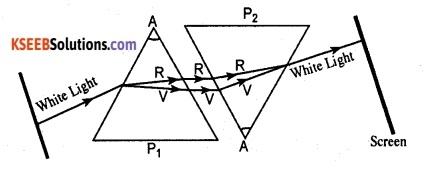
This shows that white light is a combination of seven colours.
Question 45.
What is spectrum of light? Name the colours present in the spectrum of white light
Answer:
The band of colours obtained by the dispersion of composite light is called spectrum. The spectrum of white light consists of violet, indigo, blue, green, yellow, orange and red colours.
Question 46.
Mention any four phenomena that can be observed due to atmospheric refraction of light on the earth.
Answer:
The various phenomena that involve refraction of light caused by the atmosphere of the earth are:
- Early sunrise and delayed sunset
- Twinkling of stars
- Formation of rainbow
- The apparent random wavering or flickering of objects when seen through a turbulent stream of hot air rising above a fire or a radiator.
![]()
Question 47.
What is formation of rainbow due to? Why can’t we see all the colours in a rainbow?
Answer:
A rainbow is a natural spectrum appearing in the sky after a rain shower. It is formed due to dispersion of sunlight by droplets of water present in the atmosphere. These droplets of water act like tiny prisms and cause the splitting of white light into its constituent colours. We cannot see all the colours in a rainbow because colours overlap.
Question 48.
Name the three major phenomena that contribute to the formation of a rainbow. In which direction do we usually see a rainbow formed in the sky?
Answer:
Three phenomena such as refraction, dispersion and total internal reflection contribute to the formation of a rainbow. The sunrays on entering, water droplets, refract and disperse, then reflect back internally. Finally, the light rays refract again when they come out of the raindrop. Due to the combined effect of refraction, dispersion of light and internal reflection, different colours reach the observer’s eye.
Question 49.
Draw a simple ray diagram showing the refraction, dispersion and total internal reflection happening in a raindrop during the formation of rainbow.
Answer:
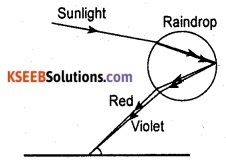
Question 50.
Explain the phenomenon of formation of rainbow in the sky.
Answer:
A rainbow is a natural spectrum caused in the sky due to the combined effect of three phenomena namely refraction, dispersion and total internal reflection. The tiny droplets of water hanging in air act like tiny prisms. When sunlight falls on these water droplets they undergo refraction and break up the constituent colours of sunlight. The raindrops reflect the dispersed light internally. When this light enters our eyes the rainbow is seen in the sky.
Question 51.
The atmosphere surrounding the earth is composed of air. How does refraction occur within the atmosphere although there is only one medium such as air?
Answer:
The air just above the earth becomes hotter than the air further up. The hotter air is less dense than the cooler air above it. Therefore, these layers of air with different density have slightly different refractive index. This is why light gets refracted while passing through different layers of the atmosphere. This is known as atmospheric refraction.
Question 52.
We observe the apparent random wavering or flickering of objects when we see them through a turbulent stream of hot air rising above a fire or a radiator. How do you explain this?
Answer:
The air just above the fire or hot radiator becomes hotter than the air further up. The hotter air is less dense than the cooler air above it. Therefore, these layers of air with different density have slightly different refractive index. Since the physical conditions of the medium of air are not stationary, the apparent position of the object, as seen through the hot air, fluctuates. This wavering is thus an effect of atmospheric refraction.
![]()
Question 53.
Give two examples of optical phenomena which occur in nature due to atmospheric refraction.
Answer:
Two of the effects caused by atmospheric refraction are:
- Twinkling of stars, and
- Advance sunrise and delayed sunset.
Question 54.
What is the twinkling of stars due to?
Answer:
The twinkling of a star is due to atmospheric refraction of starlight.
Question 55.
Explain why the planets do not twinkle.
Answer:
Planets are very close to us as compared to the distance between stars and earth. They appear as a collection of large number of point-sized sources of light (the reflected light from the sun). These different points produce either brighter or dimmer effect in such a way that the total variation in amount of light entering the eye from all sources averages out to zero. Hence, the twinkling effects of the planets are nullified and they do not twinkle.
![]()
Question 56.
Why do stars twinkle?
OR
How do stars twinkle? Explain.
Answer:
Stars may be considered as point-sized sources of light. The starlight that enters the atmosphere undergoes refraction continuously before it reaches the earth. The atmospheric refraction is caused due to varying refractive index of air at different altitudes.
Since the atmosphere bends starlight towards the normal, the apparent position of the star is slightly different from its actual position. The star appears slightly higher than its actual position when viewed near the horizon.
This shift in the apparent position of the star is continuous as the physical conditions on the earth’s atmosphere are not stationary. As a result, starlight entering the eye flickers. The star sometimes appears brighter, and at some other time, fainter. This gives the twinkling effect.
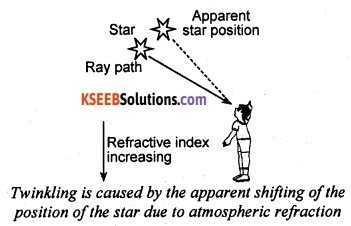
Question 57.
Stars appear to twinkle but planets do not appear to twinkle. Why?
Answer:
Planets, being larger in size, can be taken as a collection of large number of point-sized objects. The refraction effect of light rays coming from such an extended object will nullify the twinkling effect and hence planets do not twinkle.
Question 58.
How do you explain early sunrise and delayed sunset?
Answer:
Sunrise is defined as the moment that the Sun first appears just over the horizon. This means that we can’t see the Sun before it appears above the horizon. However, the Sun is visible to us about two minutes before the actual sunrise, and about two minutes after the actual sunset.
This is because of the atmospheric refraction of the light from the Sun by the Earth’s atmosphere. Earth’s atmosphere bends the path of the light so that we see the Sun in a position slightly above. Therefore, sun becomes visible before sunrise. Similar things happen during sunset. Therefore, we see the sun for about two minutes even after sunset.
![]()
Question 59.
The time difference between the actual subset and the apparent sunset is about two minutes. What is the reason for this? Explain with the help of a diagram.
Answer:
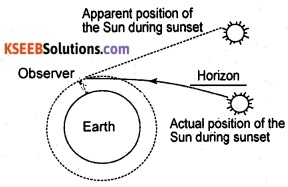
When the sun has set, the position of the sun appears to have shifted to a slightly higher position due to the refraction of the sun’s light by the atmosphere of the earth. Therefore, the sun would still be visible to us even after it is below the horizon. It is the atmospheric refraction that causes a time difference of about two minutes between actual sunset and apparent sunset.
Question 60.
The sun becomes visible to us two minutes before actual sunrise. How do you account for this?
Answer:
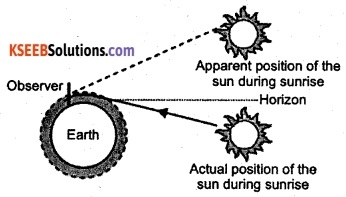
Sunrise is defined as the moment that the Sun first appears just over the horizon. Obviously we should not be able to see the sun before it actually rises above the horizon. However, due to refraction of light by the atmosphere, the sun’s apparent position is shifted to a slightly higher point. This makes the sun visible even before sunrise. This explains the time difference of sighting the sun two minutes earlier than actual sunrise.
Question 61.
What is meant by scattering of light? Give examples for scattering of light.
Answer:
The phenomenon by which a beam of light is redirected in many different directions when it interacts with a particle of matter is called scattering of light.
The blue colour of the sky, colour of water in deep sea, the reddening of the sun at sunrise and sunset are due to scattering of light.
Question 62.
What is Tyndall effect? Explain with an example.
Answer:
The phenomenon of scattering of light by colloidal particles is called Tyndall effect. The path of a beam of sunlight coming through a window becomes visible due to the scattering of light by the dust particles in the room. This is an instance of Tyndall effect. Similarly, the path of light becomes visible in a smoke-filled room due to Tyndall effect.
![]()
Question 63.
What is the relationship between the size of the scattering particles and the colour of the scattered light?
Answer:
Finer particles scatter light of shorter wavelengths (in the blue region) while larger particles scatter light of longer wavelengths (in the red region).
Question 64.
How do you explain the blue colour of the sky?
Answer:
The sky appears blue when seen from the earth. The blue colour of the sky can be explained on the basis of scattering of light. The molecules present in the atmosphere are ideally suited to scatter blue light. The sky appears blue because we see it through the blue light scattered by the atmospheric air.
Question 65.
Why does the sky appear dark instead of blue to an astronaut?
Answer:
The sky appears blue because we see it through the blue light scattered by the atmospheric air. However, there is no atmosphere in space to scatter blue light. Hence the sky appears dark to an astronaut.
Question 66.
What will be the colour of the sky when it is observed from a place in the absence of any atmosphere? Explain.
Answer:
We see the sky as coloured because the molecules present in our atmosphere interact with the sunlight passing through it and scatter light of certain wavelengths. The type of scattering responsible for blue sky is known as Rayleigh scattering. In the absence of any atmosphere, there will be no scattering of sunlight and hence the sky will appear dark.
Question 67.
Why does the sun appear reddish at sunrise and sunset?
OR
Why does the sun appear reddish early in the mornine?
Answer:
The reddish appearance of the sun at sunrise and sunset can be explained on the basis of scattering of light. During sunrise and sunset, the sun is near the horizon. Therefore, the light of the sun has to pass through thicker layers of air and larger distance in the earth’s atmosphere before reaching our eyes.
The blue component of sunlight gets almost completely scattered in different directions and the light that reaches our eyes is of longer wavelengths. Therefore, the sun appears reddish during sunrise and sunset.
![]()
Question 68.
Why does the Sun appear reddish early in the morning? Explain with the help of a diagram.
Answer:
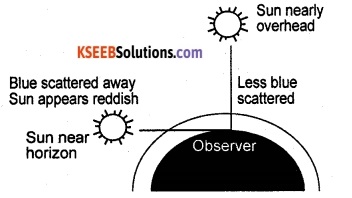
The molecules in the earth’s atmosphere are ideally suited to scatter blue light. During early morning, the sun is near the horizon. Therefore, the light of the sun will have to pass through denser layers of the atmosphere and over long distances before reaching our eyes.
During this process, the blue component of sunlight is almost completely scattered away and the light that reaches our eyes is largely in the red region. Therefore, the sun appears reddish during early morning.
Question 69.
Why does the sun appear white during midday?
Answer:
During midday, the sun is almost right above us. Therefore, the sunlight will largely pass through less dense regions of the atmosphere and shorter distance before reaching our eyes. Therefore, less amount of blue light present in sunlight is scattered and the light that reaches our eyes has almost all the components of white light. Hence the sun appears white during midday.
![]()
Question 70
How do you show experimentally why the sky appears blue and the sun appears reddish during sunrise and sunset?
Answer:
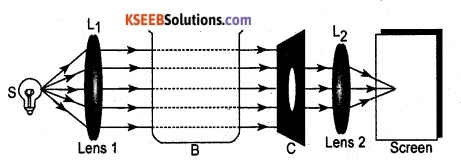
Place a strong source (S) of white light at the principal focus of a converging lens L1. This lens provides a parallel beam of white light. Pass this beam through a sodium thiosulphate solution taken in glass beaker, B. Allow the beam that emerges out of the beaker to pass through a circular hole of a screen. Pass the parallel beam of light that emerges out of the hole through another converging lens L2.
Obtain the image of the source on a screen placed at the principal focus of the second lens. The image will be in the form of a whitish circular patch of light. Now add 3 – 5 drops of concentrated sulphuric acid to the sodium thiosulphate solution and stir.
Keep observing the solution and the image formed on the screen. The solution gradually turns blue due to the scattering of blue light by the particles of the solution. The whitish patch of light on the screen gradually turns to red because the light that reaches the screen is almost free of blue light. After some time, the image disappears from the screen. This explains the blue colour of the sky and the reddish appearance of the sun during sunrise and sunset.
Question 71.
Water mixed with milk is taken in beaker ‘A ’ and sugar solution is taken in beaker ‘B ’. Light is passed through both the beakers. In which beaker is the path of light visible? Why?
Answer:
The path of light is visible in beaker ‘A’ that contains milk. Milk is a colloidal solution that scatters light. When a beam of light strikes the particles of milk, the path of the beam becomes visible, i.e., scattering of light by colloidal particles gives rise to Tyndall effect.
![]()
Fill In The Blanks
1. The screen of the human eye is called retina
2. The ability of the eye to adjust the focal length of its lens is called accommodation
3. The near point of a normal adult eye is 25 cm
4. Breaking up of the constituent colours of composite light is called dispersion
5. The defect of the eye due to which nearby objects cannot be seen clearly, is called hypermetropia / longsightedness
6. Myopia can be corrected with spectacles fitted with suitable concave lens
7. The constituent colour of white light that has the highest wavelength is red
Multiple Choice Questions
Question 1.
The human eye can focus objects at different distances by adjusting the focal length of the eye lens. This is due to
(A) presbyopia.
(B) accommodation.
(C) near-sightedness.
(D) far-sightedness.
Answer:
(B) accommodation.
![]()
Question 2.
The human eye forms the image of an object at its
(A) cornea.
(B) iris.
(C) pupil.
(D) retina.
Answer:
(D) retina.
Question 3.
The least distance of distinct vision for a young adult with normal vision is about
(A) 25 m.
(B) 2.5 cm.
(C) 25 cm.
(D) 2.5 m.
Answer:
(C) 25 cm.
Question 4.
The change in focal length of an eye lens is caused by the action of the
(A) pupil.
(B) retina.
(C) ciliary muscles.
(D) iris.
Answer:
(C) ciliary muscles.
![]()
Question 5.
Scattering of light by particles involves
(A) change in direction of light
(B) dispersion
(C) reflection
(D) refraction
Answer:
(A) change in direction of light
Question 6.
Which of the following phenomena of light are involved in the formation of a rainbow?
(A) Dispersion, scattering and total internal reflection
(B) Reflection, dispersion and total internal reflection
(C) Reflection, refraction and dispersion
(D) Refraction, dispersion and total internal reflection
Answer:
(D) Refraction, dispersion and total internal reflection
Question 7.
A person has an elongated eyeball and hence is suffering from shortsightedness. He requires spectacles fitted with
(A) convex lens to focus distant objects
(B) concave lens to focus distant objects
(C) convex lens to focus near objects
(D) concave lens to focus near objects.
Answer:
(B) concave lens to focus distant objects
Question 8.
At noon, the sun appears white as
(A) light is least scattered
(B) all the colours of the white light are scattered away
(C) blue colour is scattered the most
(D) red colour is scattered the most
Answer:
(A) light is least scattered
Question 9.
The bluish colour of water in deep sea is due to
(A) the presence of algae and other plants found in water
(B) scattering of light
(C) reflection of sky in water
(D) absorption of light by the sea
Answer:
(B) scattering of light
![]()
Question 10.
Twinkling of stars is due to atmospheric
(A) dispersion of light by water droplets
(B) internal reflection of light by clouds
(C) refraction of light by different layers of atmospheric air
(D) scattering of light by dust particles
Answer:
(C) refraction of light by different layers of atmospheric air
Question 11.
The clear sky appears blue because
(A) blue light gets absorbed in the atmosphere
(B) lights of all other colours are scattered more than violet and blue colour lights by the atmosphere
(C) ultraviolet radiations are absorbed in the atmosphere
(D) violet and blue lights get scattered more than lights of all other colours by the atmosphere
Answer:
(D) violet and blue lights get scattered more than lights of all other colours by the atmosphere
Question 12.
The danger signals installed at the top of tall buildings are red in colour. These can be easily seen from a distance because among all the colours, red light
(A) is scattered the most by smoke or fog
(B) is scattered the least by smoke or fog
(C) is absorbed the most by smoke or fog
(D) moves fastest in air
Answer:
(B) is scattered the least by smoke or fog
Question 13.
Dispersion is a phenomenon involving
(A) refraction of light
(B) reflection of coloured light
(C) combining of coloured lights into white light
(D) separation of light into its spectrum
Answer:
(B) reflection of coloured light
![]()
Question 14.
Because of atmospheric refraction, the Sun actually sets
(A) after we see it disappear
(B) before we see it disappear
(C) when it just disappears
(D) hours before we see it disappear
Answer:
(B) before we see it disappear
Question 15.
Which of the following statements is correct?
(A) A person with myopia can see distant objects clearly.
(B) A person with hypermetropia can see nearby objects clearly.
(C) A person with myopia can see nearby objects clearly.
(D) A person with hypermetropia cannot see distant objects clearly.
Answer:
(C) A person with myopia can see nearby objects clearly.
Question 16.
The colour of light that refracts most on entering a glass prism is
(A) yellow
(B) violet
(C) blue
(D) red
Answer:
(D) red
Question 17.
Which of the following colours of light is least scattered by fog, dust or smoke? .
(A) Violet
(B) Blue
(C) Red
(D) Yellow
Answer:
(C) Red
![]()
Question 18.
A person cannot see distinctly objects kept beyond 2 nu This defect can be corrected by using a lens of power
(A) +0.2 D
(B) -0.2 D
(C) +0.5 D
(D) -0.5 D
Answer:
(D) -0.5 D
Question 19.
Red coloured light is used in traffic signals to indicate the vehicles to stop, because compared to other colours red light
(A) has high frequency
(B) scatters more
(C) has less wavelength
(D) scatters less
Answer:
(D) scatters less
Question 20.
The characteristic of the image of an object formed on the retina by the lens of the eye is
(A) real and inverted
(B) virtual and erect
(C) real and erect
(D) virtual and inverted
Answer:
(A) real and inverted
![]()
Match The Following
Question 1.
| Column A | Column B |
| 1. Rainbow | a. Bouncing back of light from a surface |
| 2. Tyndall effect | b. Causes blue colour of the sky |
| 3. Myopia | c. Caused by dispersion of light |
| 4. Hypermetropia | d. Scattering of light by colloidal particles |
| 5. Scattering of light | e. Cannot see nearby objects clearly |
| f. Cannot see distant objects clearly |
Answer:
1 – c, 2 – d, 3 – f, 4 – e, 5 – b.
